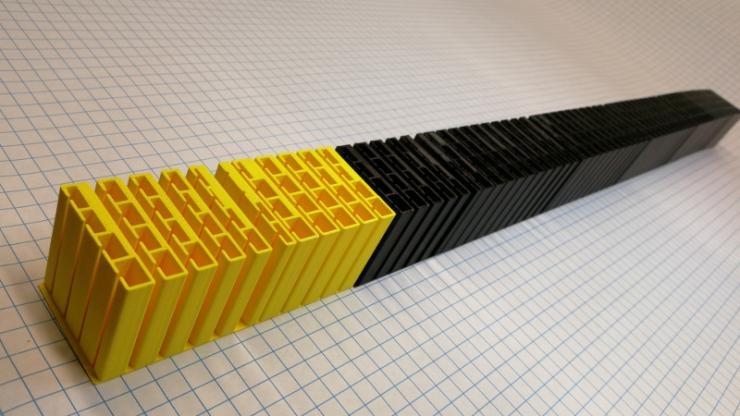Apr 11 2018
Metamaterials researchers from the Duke University have shown the design and structure of a thin material that can regulate the redirection and reflection of sound waves with nearly flawless efficiency.
 This metamaterial surface has been engineered to perfectly and simultaneously control the transmission and reflection of incoming sound waves. (Image credit: Duke University)
This metamaterial surface has been engineered to perfectly and simultaneously control the transmission and reflection of incoming sound waves. (Image credit: Duke University)
While many theoretical methods to design such a device have been suggested, they have struggled to concurrently regulate both the transmission and reflection of sound in precisely the desired manner, and none have been experimentally validated.
The latest design is the first to show total, near-perfect control of sound waves and is rapidly and easily fabricated using 3D printers. The results have been published online in the April 9 issue of Nature Communications.
Controlling the transmission and reflection of sound waves this way was a theoretical concept that did not have a path to implementation—nobody knew how to design a practical structure using these ideas. We solved both of those problems. Not only did we figure out a way to design such a device, we could also make one and test it. And lo and behold, it actually works.
Steve Cummer, Professor of Electrical & Computer Engineering - Duke
The new design uses a group of materials known as metamaterials—artificial materials that control waves like light and sound using their structure rather than their chemistry. For instance, while this specific metamaterial is composed of 3D printed plastic, it’s not the properties of the plastic that are significant—it’s the shapes of the device’s characteristics that allow it to regulate sound waves.
The metamaterial is composed of a series of rows of four hollow columns. Each column is approximately one-half of an inch on a side having a narrow opening cut down the middle of one side, making it look slightly like the world’s deepest Ethernet port. While the device shown in the paper is 1.6 inches tall and almost 3.5 feet long, its height and width are immaterial—it could theoretically stretch on endlessly in either direction.
The team controls how the device regulates sound through the width of the channels between each row of columns and the size of the cavity within each individual column. Certain columns are wide open while others are virtually closed off.
To comprehend why, imagine someone blowing air across the top of a glass bottle—the pitch the bottle creates depends on the quantity of liquid left inside the bottle. Likewise, each column resonates at a different frequency based on the amount of plastic it is filled in with.
As a sound wave moves through the device, each cavity resonates at its set frequency. This vibration not only influences the speed of the sound wave but interacts with its adjoining cavities to tame transmission as well as reflection.
Previous devices could shape and redirect sound waves by changing the speed of different sections of the wave front, but there was always unwanted scattering. You have to control both the phase and amplitude of both the transmission and reflection of the wave to approach perfect efficiencies.
Junfei Li, Doctoral Student in Cummer’s Laboratory & First Author
To further complicate matters, the vibrating columns not only interact with the sound wave, but also with their neighboring columns. Li had to write an ‘evolutionary computer optimization program,’ to sort all the design permutations.
The team feeds the program the boundary conditions necessary on each side of the material to order how they want the outgoing and reflected waves to act. After checking out a random set of design solutions, the program puts together various combinations of the best solutions, adds random “mutations,” and then repeats the numbers. After a number of iterations, the program ultimately “evolves” a set of design parameters that deliver the desired result.
In the paper, Cummer, Li, and colleagues reveal that one such set of solutions can redirect a sound wave traveling directly at the metamaterial to a sharp 60-degree outgoing angle with an efficiency of 96%. Earlier devices would have been fortunate to accomplish 60% efficiencies under such conditions. While this particular arrangement was engineered to manipulate a sound wave at 3,000 Hertz—a very high pitch not dissimilar to hearing a “ringing in your ears”—the metamaterials could be scaled to impact virtually any wavelength of sound.
The researchers and their collaborators are subsequently planning to use these ideas to the control of sound waves in water for applications such as sonar, although thus far there aren’t any ideas for applications in air.
When talking about waves, I often fall back on the analogue of an optical lens. If you tried to make really thin eyeglasses using the same approaches that these sorts of devices have been using for sound, they would stink. This demonstration now allows us to manipulate sound waves extremely accurately, like a lens for sound that would be way better than previously possible.
Steve Cummer, Professor of Electrical & Computer Engineering - Duke
This study was supported by the Office of Naval Research (N00014-13-1-0631) and the National Science Foundation (1641084).